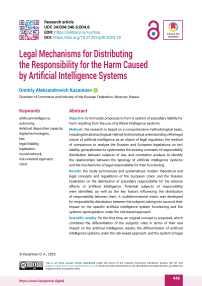Legal Mechanisms for Distributing the Responsibility for the Harm Caused by Artificial Intelligence Systems
Автор: Kazantsev D. A.
Журнал: Journal of Digital Technologies and Law @lawjournal-digital
Статья в выпуске: 3 (3), 2025 года.
Бесплатный доступ
Objective: to formulate proposals to form a system of subsidiary liability for harm resulting from the use of artificial intelligence systems. Methods: the research is based on a comprehensive methodological basis, including the abstract logical method for theoretical understanding of the legal nature of artificial intelligence as an object of legal regulation; the method of comparison to analyze the Russian and European legislations on tort liability; generalization to systematize the existing concepts of responsibility distribution between subjects of law; and correlation analysis to identify the relationships between the typology of artificial intelligence systems and the mechanisms of legal responsibility for their functioning. Results: the study summarizes and systematizes modern theoretical and legal concepts and regulations of the European Union and the Russian Federation on the distribution of subsidiary responsibility for the adverse effects of artificial intelligence. Potential subjects of responsibility were identified, as well as the key factors influencing the distribution of responsibility between them. A multidimensional matrix was developed for responsibility distribution between the subjects, taking into account their impact on the specific artificial intelligence system functioning and the systems typologization under the risk-based approach. Scientific novelty: for the first time, an original concept is proposed, which combines the differentiation of the subjects’ roles in terms of their real impact on the artificial intelligence results; the differentiation of artificial intelligence systems under the risk-based approach; and the system of legal presumptions of responsibility distribution corresponding to the above two classifications. The novelty lies in the creation of a multidimensional matrix of subsidiary liability, which allows taking into account many factors when determining the subject of responsibility in each specific case of harm caused by artificial intelligence systems, which differs significantly from existing unilateral approaches to this issue. Practical significance: the research conclusions and suggestions can be used to develop the doctrine of subsidiary responsibility in the field of artificial intelligence use, to develop and modify the legal norms regulating artificial intelligence. The proposed multidimensional matrix of responsibility distribution can serve as a theoretical basis for improving judicial practice in cases of compensation for damage caused by artificial intelligence systems, as well as for creating an effective balance between stimulating the development of AI technologies and ensuring the protection of the rights and legitimate interests of individuals and legal entities.
Artificial intelligence, autonomy, delictual dispositive capacity, digital technologies, law, legal lliability, legislation, neural network, risk-oriented approach, robot
Короткий адрес: https://sciup.org/14134125
IDR: 14134125 | УДК: 34:004:346.6:004.8 | DOI: 10.21202/jdtl.2025.18


